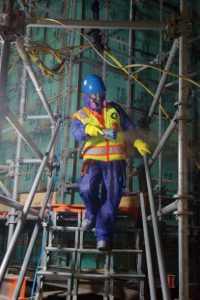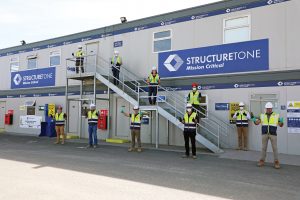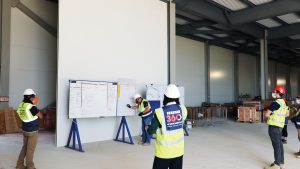TEAMWORK AT ITS BEST: Communication and Collaboration on the Job
As cities across the globe implemented stay-at-home orders and limited public activities, the construction industry (among many others) was contending with a slew of unknowns. Do we need to shut down our jobsites? Where do we find PPE? How do we practice social distancing in the confines of our sites?
 Despite different governments, geographies, and circumstances, Pavarini McGovern in New York and Structure Tone in Dublin shared a number of strategies for managing the ever-moving targets related to COVID-19—which ultimately helped both companies protect their jobsites, inspire their workers, and help their clients continue to make progress on their projects.
Despite different governments, geographies, and circumstances, Pavarini McGovern in New York and Structure Tone in Dublin shared a number of strategies for managing the ever-moving targets related to COVID-19—which ultimately helped both companies protect their jobsites, inspire their workers, and help their clients continue to make progress on their projects.
Two heads are better than one. As a shutdown loomed in New York, Pavarini McGovern (PMG) was preparing for how that affect-ed their sites—most of which are massive high-rises. “These projects can’t stop on a dime,” says Ed Lydon, general superintendent for PMG. “We had to get plans in place right away for how we could continue to work safely.”
To do so, Lydon, Marc DePaul, PMG VP of operations, and Sean O’Reilly, PMG safety director, began coordinating immediately with the Contractors Association of Greater New York (CAGNY), the NYC Department of Buildings, state officials, subcontractors, and the unions to determine what kind of work could continue, what health and safety guidelines they should be following, and what challenges they could solve together.
“We needed to make sure our plans could all coexist and that they understood our needs and we understood theirs,” Lydon says. In Dublin, Structure Tone took a similar approach, working directly with subcontractors and partners on drafting plans, while coordinating with the CIF (Construction Industry Federation) to ensure all plans and protocols synced up with what the industry as a whole was endorsing.
“Through the CIF, the Irish construction industry agreed on and rolled out protocols consistently,” says Stephen Quinn, Structure Tone Dublin project director. “So once that was settled, we had a backdrop of what we needed to do and how we were going to do it.”

Plan the work, work the plan. Once protocols and guidance were established, training and implementation became the focus—which really boiled down to effective communication.
“We knew we had to get everyone to embrace a whole new mindset,” says Quinn. “So rather than go down the route of telling people to protect themselves, we made it equally about protecting your family and friends at home.”
The Structure Tone team designed a mandatory training module for the principals and senior directors of the subcontractors, who then cascaded that message to their teams. With their long-term, large-scale projects, Pavarini McGovern also created a “quick sheet” version of their training for workers who had already gone through the COVID-19 training before but needed a refresher as they rejoined the job site. “Through our jobsite badging system, we could log everyone who went through the full orientation or the reorientation. It’s been a very effective way of keeping track of everyone,” says Lydon.
Optics also became a key focus on project sites to complement the messages being driven by both the Structure Tone and Pavarini McGovern teams and their trade partners. Temperature taking stations, multiple hand-washing areas, frequent and obvious sanitization and cleaning—these measures were both elements of the jobsite guidelines and visual cues that the construction management team was taking worker safety seriously. “We really wanted to give them the visual assurance that we are looking out for their well-being,” says Lydon. “We wanted them to see that we were going above and beyond.”

Keep your head on a swivel. The constant updates to the data and guidance surrounding the pan-demic also forced project teams to be prepared at all times for quick responses to new circumstances. For example, PMG set up its large jobsites into worker “pods” so that if anyone suspected contact with the virus, PMG could isolate and sanitize that limited area versus an entire 30-story project site.
Structure Tone Dublin instigated a process of continuous improvement as the virus evolved, eliciting feedback from the CIF, the supply chain, the work-force on the ground, and even peers in the industry. In one example, after hearing from workers and the CIF on the pros and cons of various PPE, Structure Tone worked with a local supplier to develop a clip-on face shield that can attach to a hard hat. “In the early days we were learning and tweaking,” says Quinn. “We worked closely with our partners throughout so that when the shutdown ended, we were all ready, with a rock-solid plan, to get back to work safely.”
Seize the momentum. While COVID-19 certainly posed new challenges to construction, both Quinn and Lydon see some long-term benefits from the lessons learned. “When this first started, we were all expecting the new protocols to create massive inefficiencies,” says Quinn. “But we have seen so much more input and planning from everyone, from the clients to the subcontractors to the supply chain. There is a lot more strategy and collaboration around how to manage a project.”
And while in-person collaboration is always a favorite, Lydon says the virtual meeting will likely remain in place, at least some of the time. “We made it work, and now everyone is used to it,” he says. “It’s nice to know we have this option now and people can keep up to speed on the project without having to visit the site.”
